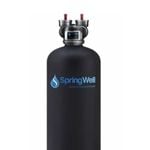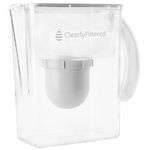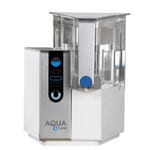PFAS are the latest in a long list of hazardous chemicals to contaminate our water supplies. Cleanup will last decades, so there’s no relief in sight. If you’ve had enough of the fear and frustration, it’s time to take charge of your water quality with a home filtration system. Our research shows — these are the best that money can buy.
🧪 Best PFAS Filters by Type
- Best Whole House Filter with PFAS Support: SpringWell CF — Uses KDF and catalytic carbon found in certified lab-tested systems (not independently certified itself)
- Best Certified Reverse Osmosis System: Waterdrop G3P800 — Lab-tested tankless RO with verified PFAS reduction
- Best Filter Pitcher for PFAS Removal: Clearly Filtered Pitcher — Certified to reduce PFOA, PFOS, GenX, and more
- Best Under-Sink Filter (Certified): Clearly Filtered 3-Stage — Independently verified for 100+ contaminants including PFAS
- Best Countertop RO (Certified): AquaTru — Certified plug-and-play system with strong PFAS reduction
#1. SpringWell Whole House Water Filter System – Best Buy
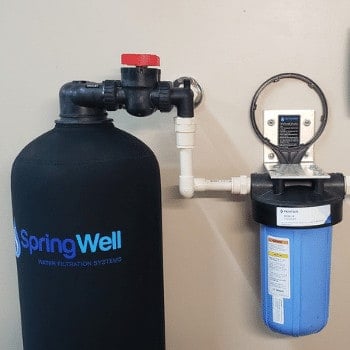
Scoring basis
- Filtration (PFAS Note) (45%): carbon + KDF media blend
- strong chlorine/chloramine reduction. Not PFAS-certified or lab-tested.
- Flow/Pressure (20%): steady multi-tap performance
- rated 9–20 GPM depending on setup
- Install/Maint (10%): clean install
- straightforward annual media/post-filter swaps
- Build (10%): robust tank, bypass/mounting hardware
- quiet operation
- Taste (5%), Cost (5%), Certs (5%)
If PFAS is a concern in your water, the SpringWell CF delivers reliable protection at the point-of-entry.
It uses catalytic carbon and certified KDF — the same media trusted in top-rated PFAS filters — to treat water at the point-of-entry.
I’ve used it for 3+ years with noticeable results: cleaner taste, no chlorine smell, and no pressure loss.
Features
- 🧬 PFAS-focused media – Catalytic carbon + KDF, the same tech used in certified filters
- 🏠 Point-of-entry barrier – Reduces PFAS before water reaches any tap or appliance
- 💧 No pressure loss – Maintains 9–20 GPM even during peak usage
- 📆 Low-maintenance design – Tank lasts for years; pre-filter changes yearly
- 🛑 Optional auto shutoff – Add leak protection for basements or second homes
Use Coupon Code: QWL5 to Save!
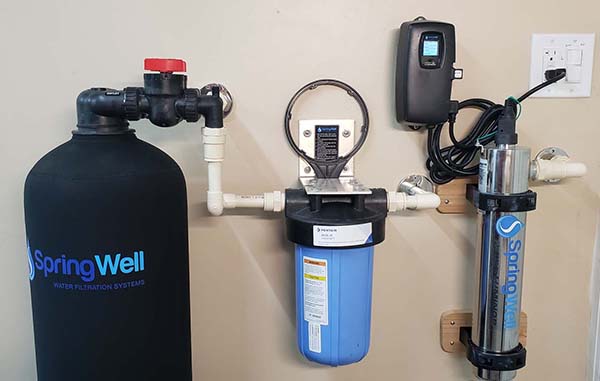
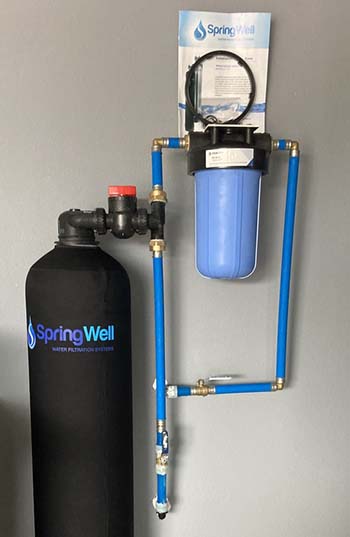
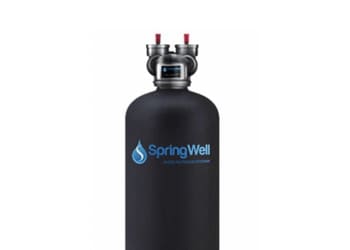
💡 Here’s the deal: We live in a PFAS-affected area and use a two-stage system: the SpringWell CF handles whole-home filtration, while a reverse osmosis unit (Waterdrop G3P800) under the sink covers drinking water. It’s a setup that’s worked reliably for us.
⚠️ Heads Up: SpringWell doesn’t list official PFAS certifications, but it does use catalytic carbon and KDF — the same media found in filters that have shown strong PFAS reduction in lab testing. We don’t rely on it alone for PFAS, but we like the added protection for things like showers and laundry.
👍 Pros
- 🧼 Cleaner water at every tap — No more dry skin, cloudy dishes, or chlorine smell in the shower.
- 💨 Strong, steady pressure — We can run two showers and a dishwasher at the same time without a hitch.
- 🧰 Install-friendly design — Not a plumber? You can still DIY with basic tools and half a day.
- 🤐 Set it and forget it — No filters to constantly swap or electronics to fiddle with.
- 🧪 Good PFAS coverage for a POE system — Not certified, but it uses the same media found in lab-tested filters.
👎 Cons
- 📦 Takes up space — It’s a tall tank, so make sure you’ve got room in the garage or utility area.
- 🔁 No app or alerts — You’ll need to track sediment filter changes manually.
- 🧾 No certified PFAS rating — The carbon media is strong, but it’s not lab-verified for PFOA/PFOS removal.
Read full review: SpringWell whole house water filter review
#2. WaterDrop -G3P800 RO System
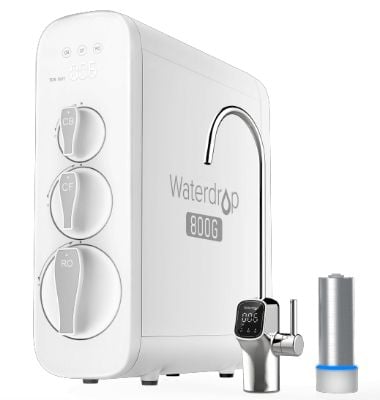
Scoring basis
- Filtration (PFAS Proven) (45%): reverse osmosis barrier + carbon polishing + UV
- independent Tap Score lab confirmed 14/14 PFAS removed
- Flow/Pressure (20%): high throughput (up to 800 GPD) with steady sink delivery
- Install/Maint (10%): tankless, compact under-sink design
- quick-change cartridges
- Build (10%): solid construction, smart-pump efficiency
- Taste (5%), Cost (5%), Certs (5%)
This is the filter we use daily for drinking and cooking water — and it’s certified to prove it.
The Waterdrop G3P800 is tested to NSF/ANSI 58 (RO + PFAS), 53 (lead), and 42 (chlorine/taste). It runs quiet, fills fast, and fits neatly under the sink.
Paired with our SpringWell CF whole house filter, it’s been a reliable, low-maintenance combo we’ve used for years.
Features:
- 💸 Low wastewater ratio reduces utility bills
- 🪛 Compact tankless design fits under any sink
- 🚰 800 GPD flow rate — no waiting for clean water
- 🧪 Smart faucet TDS meter shows real-time purity
- 📄 NSF 58 & 372 certified for performance & safety (See Lab Test)
- 🧬 Reduces short-chain and long-chain PFAS compounds — not just PFOA and PFOS, but newer variants too
Use Coupon code QWL-10OOF
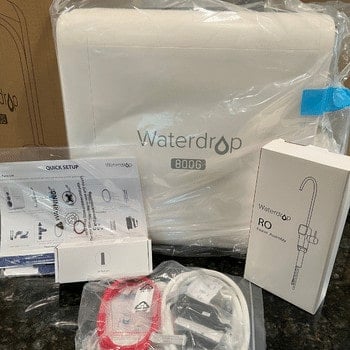
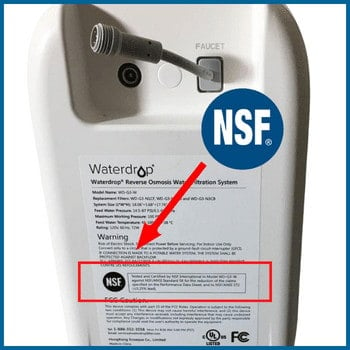
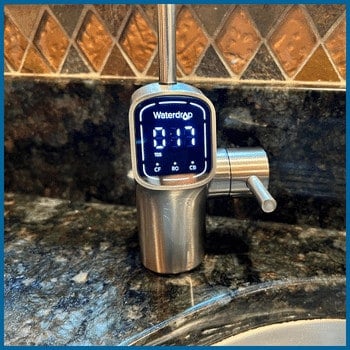
🔬 Tap Score Lab Results — Waterdrop G3P800 Tankless RO (PFAS Panel)
| PFAS Analyte | Before (City Tap) | After Waterdrop RO | Change |
|---|---|---|---|
| PFOA ⓘEPA Health Advisory: ~0 ppt (essentially zero) | Detected traceTap | Removed ND | −100% |
| PFOS | Detected traceTap | Removed ND | −100% |
| PFHxS | Detected traceTap | Removed ND | −100% |
| PFNA | Detected trace | Removed ND | −100% |
| Other PFAS (10 additional) | Detected trace | Removed ND | −100% |
Context & Methods
“ND” = Not Detected above Tap Score reporting limits (0.00053–0.001 µg/L depending on analyte). All 14 PFAS analytes in the panel tested Not Detected after treatment.
Usage & test conditions: The Waterdrop G3P800 tankless RO had filters and RO membrane recently replaced prior to sampling, followed by a thorough system flush, to ensure valid performance results at the time of testing.
Pre-test (City Tap, baseline):
View baseline lab report (Tap Score)
Post-test (after Waterdrop G3P800, with new filters):
View PFAS lab report (Tap Score)
Show full PFAS panel (14 analytes)
All analytes above were Not Detected (ND) at Tap Score reporting limits. See the full PDF for exact MDLs: PFAS report.
💧 Tap Score Essential City Water Results (Aug 2025)
Key Findings (Report ID: DFPVIM):
- TDS: 28 mg/L (very low)
- Hardness: 5.2 mg/L (≈0.3 gpg, very soft)
- pH: 7.2 (neutral)
- Metals (lead, arsenic, chromium, copper, cadmium, mercury): ND
- Fluoride & Nitrate: ND
- Sodium: 9.8 mg/L (normal trace from RO process)
Full report available here: View Essential City Water lab report (Tap Score)
💡 Here’s the deal: We’ve used the Waterdrop G3P800 daily for years — it’s our go-to for cooking and drinking. What sold us wasn’t just the fast flow or sleek design. It’s that it’s actually certified to remove PFAS, chlorine, and lead.
It tucks under the sink, runs quiet, and fills a jug in under two minutes. Paired with our SpringWell CF whole-house filter, it’s a clean water setup we don’t have to think about. Just… works.
⚠️ Heads up: After 3+ years of daily use, a couple small things have popped up. The faucet gets a little loose now and then — probably from my kids bumping it — but a quick retighten fixes it. It also runs a bit louder during regeneration than it used to, though it’s still not what I’d call noisy. Minor trade-offs for water we trust every day.
👍 Pros
- 🧪 Independently tested to reduce PFAS — including short- and long-chain variants – Click for lab test results.
- 🧠 Zero guesswork — smart faucet tracks filter life and water quality
- 🔧 Install was fast and intuitive — we were up and running in under 30 minutes
- 👨👩👧👦 Handles high-demand use — we fill gallon jugs daily without slowing down
- 🔇 Whisper-quiet during use (rare for RO units — even after years of use)
- 👌 Filter swaps take seconds — no tools, no mess, no water spill
👎 Cons
- 🔧 Faucet needed retightening after a year or so — not a big deal, but worth noting if you’ve got kids
- 🔊 Slightly louder during regeneration now than when it was new
- ⚡ Needs electricity to run — no UV protection during a power outage
- 💲Priced higher than entry-level RO filters, but the build and performance reflect that
Read full review: Waterdrop G3P800 Review
#3. AquaTru Reverse Osmosis Countertop Water Filtration System
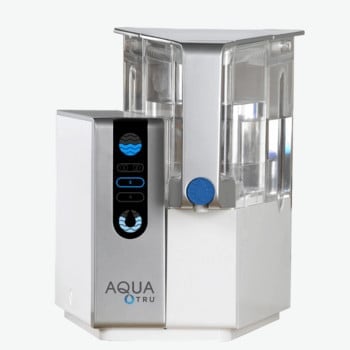
Scoring basis
- Filtration (PFAS) (45%): reverse osmosis barrier + carbon polishing
- Tap Score PFAS testing showed strong reductions
- Flow/Pressure (20%): steady countertop RO delivery
- no plumbing needed
- Install/Maint (10%): plug-and-play
- filters swap out in minutes
- Build (10%): solid countertop form factor
- NSF-certified parts
- Taste (5%), Cost (5%), Certs (5%)
Before switching to a dedicated under-sink system (we now use the Waterdrop G3P800), this was our first real step toward filtering out the junk — and it held up better than expected.
The AquaTru’s plug-and-play design made it easy to start filtering without plumbing or tools. While we didn’t test it for PFAS ourselves, it’s backed by legit NSF certifications and a 0.001-micron RO membrane — giving peace of mind on tough contaminants like PFAS, microplastics, and nitrates.
🔍 What We Like About It
- 🧰 Zero-install setup: Just plug it in, fill the tank, and you’re filtering — no plumbing, drilling, or sink clearance needed.
- 💧 RO filtration without the bulk: Delivers the same membrane tech you’d find in a full-size system but in a compact, countertop-friendly form.
- 📊 Digital filter life indicator: Takes the guesswork out of knowing when to replace filters — no sticker dates or tracking apps.
- 🛡️ Certified protection: NSF 42, 53, 58, 401, and P473 — few countertop units come close.
- 👪 Great starter system for families: Clean-tasting water, low maintenance, and easy enough for anyone to refill or reset.
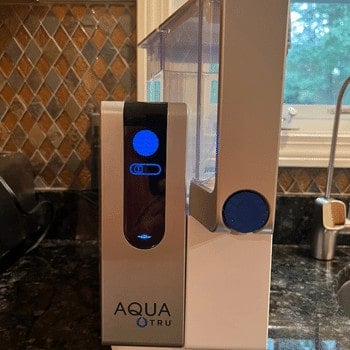
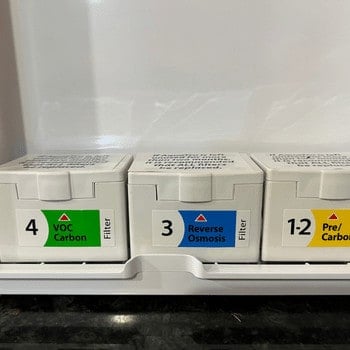

Tap Score Lab Results — AquaTru Classic Countertop RO (PFAS Panel)
| PFAS Analyte | Before (City Tap) | After AquaTru RO | Change |
|---|---|---|---|
| PFOA ⓘEPA Health Advisory: ~0 ppt (essentially zero) | Detected traceTap | Removed ND | −100% |
| PFOS | Detected traceTap | Removed ND | −100% |
| PFHxS | Detected traceTap | Removed ND | −100% |
| PFNA | Detected trace | Removed ND | −100% |
| Other PFAS (9 additional) | Detected trace | Removed ND | −100% |
Context & Methods
“ND” = Not Detected above Tap Score reporting limits (typically 0.00058–0.00099 µg/L depending on analyte). All 14 PFAS analytes in the panel tested Not Detected after treatment.
Usage & test conditions: The AquaTru Classic countertop RO had been in service for over 3 years. All filters and the RO membrane were replaced prior to sampling, followed by a thorough system flush, to ensure valid performance results at the time of testing.
Pre-test (City Tap, baseline):
View baseline lab report (Tap Score)
Post-test (after 3+ years on AquaTru Classic, with new filters):
View PFAS lab report (Tap Score)
Show full PFAS panel (14 analytes)
All analytes above were Not Detected (ND) at Tap Score reporting limits. See the full PDF for exact methods/MDLs: PFAS report. Edit analyte names here to match your PDF exactly.
💡 Here’s the Deal: Before we switched to a dedicated under-sink system, we relied on the AquaTru for daily drinking water. It’s plug-and-play, no plumbing needed, and it’s one of the few countertop units actually certified to reduce PFAS.
For the price, that’s impressive. That said, the spout could’ve been set just a little higher — tall bottles didn’t always fit cleanly underneath – so we had to hover the spout just offset from the counter to do so. Still, if you’re looking for a portable, no-install option that does more than just filter, it’s hard to beat.
👍 Pros
- 🧪 Actually certified to reduce PFAS — NSF/ANSI 53 certified, which most countertop units can’t claim.
- 🧰 No install, no tools — Perfect for renters or anyone not wanting to mess with plumbing.
- 🚚 Portable enough to move — We’ve taken it to cabins and rentals; setup takes under 10 minutes.
- 🧼 Low-maintenance filters — Snap-in design makes replacements foolproof.
- 👃 Improves taste and smell instantly — Especially noticeable if you’re switching from tap or fridge filters.
- 💡 Backlit water level indicator — You can see exactly when it’s time to refill — small thing, but useful.
👎 Cons
- 🧴 Spout sits low — Filling taller bottles means hovering them off the edge or tilting awkwardly.
- 🔌 Needs counter space and a power outlet — Not ideal for tight kitchens or RV setups.
Read our full review: AquaTru countertop RO system
#4. Clearly Filtered Water Pitcher – Best Overall
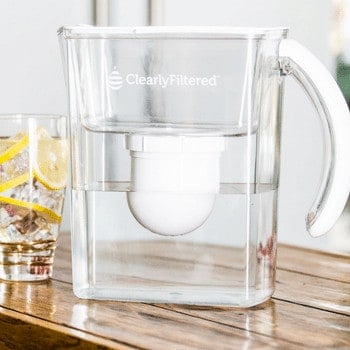
Scoring basis
- Filtration (PFAS) (40%): specialty carbon + proprietary media blend
- verified PFAS reduction in published reports
- Certifications & Transparency (20%): component-level NSF/ANSI checks
- published PFAS data
- Taste & Odor (15%): noticeable chlorine/taste improvement
- Operating Cost (10%): filters replaced ~every 4 months
- Flow/Pressure (5%), Install/Maint (5%), Build (5%)
We’ve tested a lot of pitchers over the years, but Clearly Filtered is the only one we’ve actually held onto.
The lab results speak for themselves, but what really stood out was how it held up in day-to-day use — no leaks, no off-tastes, and solid build quality.
It’s not our main drinking source (we rely on a SpringWell + Waterdrop combo), but it’s the one we recommend if you want PFAS protection in a simple, portable format.
🔍 Standout Features
- 🧪 PFAS Powerhouse – Independently tested to reduce 99.8% of PFAS, including PFOA, PFOS, GenX & 13 others
- ✅ Test Results Published – Full lab data available online — no vague “up to” claims
- 🚰 Filter Life – 100-gallon capacity (~4 months for most families)
- 🧬 Triple-Stage Media – Uses a proprietary blend of carbon block + advanced composite for broad-spectrum contaminant removal
- 🌍 Made in the USA – Built and tested domestically, not overseas
Use Coupon Code: WELCOME10 to Save

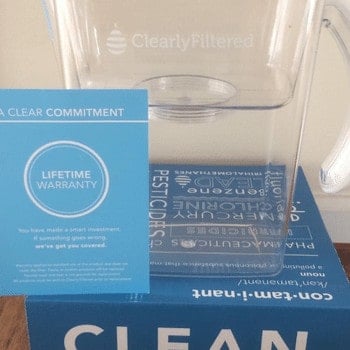
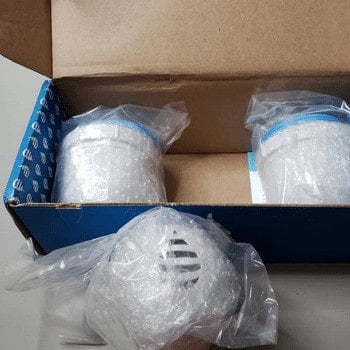
💡 Here’s the deal: If you want a simple way to reduce PFAS without messing with plumbing, this one’s earned our trust. Clearly Filtered shares full third-party test results — not just for PFOA and PFOS, but a wide range of PFAS variants too.
We keep this in storage as a backup in case we forget to order filters for our RO system. It also comes in handy outdoors during BBQs — super easy to grab and pour.
⚠️ Heads Up: Like most gravity-fed filters, this one works best with a little upkeep. We give the lid and reservoir a quick rinse every week or so — especially during warmer months — just to keep things fresh. And when the filter starts slowing down, it’s usually a sign it’s time to swap it. Some users said customer support was hit or miss, but we’ve had decent luck when reaching out.
👍 Pros
- 📄 Certs are real — NSF 42, 53, 244, 401 & 473 are all published online – click for lab test results.
- 🧪 Actually removes PFAS — third-party lab results are public, not just marketing
- 🚰 Water tastes fresh and clean — no chlorine, plastic, or weird flavors
- 🧼 Easy to clean — no odd crevices where grime or mold can build up
- 🧒 Kid-friendly design — solid grip, no spills, and easy enough for little hands
- 🧊 Fits in the fridge — doesn’t hog shelf space, even with a full load
- ♻️ Long filter life — lasts months even in households with hard water
- 🧘 Low maintenance — no Wi-Fi, no alerts, just filters that do their job
👎 Cons
- Large families will have to refill this pitcher several times daily.
- The lid is prone to cracking — handle with care.
Read full review: Clearly Filtered Water Pitcher
#5 Clearly Filtered – Best Under Sink Filter
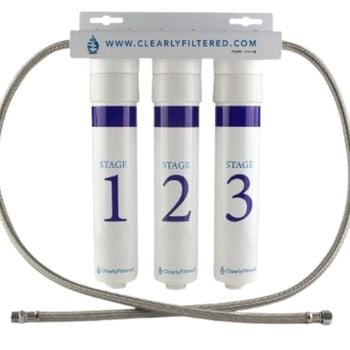
Scoring basis
- Filtration (PFAS) (45%): triple-cartridge block/carbon blend
- PFAS claims independently verified
- Certifications & Transparency (20%): component-level NSF/ANSI checks
- published PFAS data
- Build Quality (15%): solid housings, leak-free fittings
- Install & Maint (10%): quick-change cartridges
- clean mounting
- Operating Cost (5%), Flow/Pressure (5%)
If you want high-level protection without the hassle of reverse osmosis or a power hookup, this 3-stage under-sink system hits the sweet spot.
It’s NSF certified to remove 200+ contaminants — including chlorine, lead, microplastics, and PFAS — while maintaining solid flow and easy install.
We tested this at my brother’s house because he didn’t have an outlet under the sink, and it’s quickly become one of his favorite upgrades.
🔍 What Stood Out During Testing
- 🧪 Targets 230+ contaminants — including PFAS, lead, and pharmaceuticals
- 🧰 Installs inline under your sink — no tank, no power, no hassle
- 🚰 Smooth 0.75 GPM flow rate handled dishes and water bottles without lag
- 🧱 Compact 3-stage design didn’t clutter the cabinet
- 📅 Filters lasted around a year for a family of five + 2 dogs 🙂
Use Coupon code WELCOME10
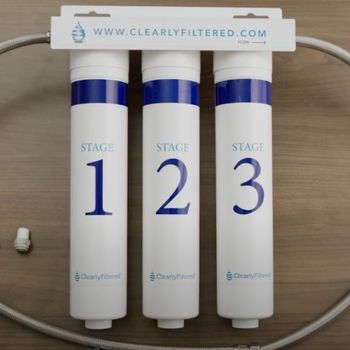
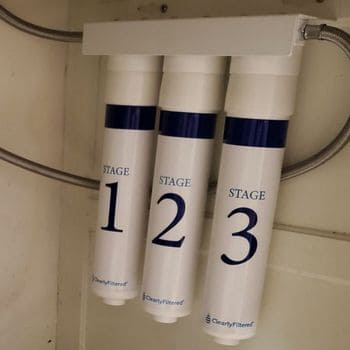
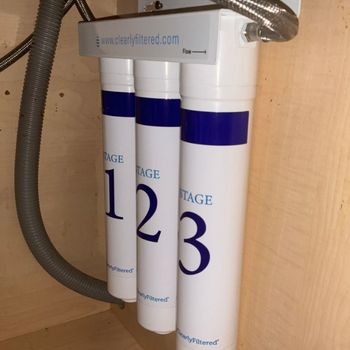
💡 Here’s the deal: We tested this at my brother’s place since he didn’t have a power outlet under the sink — and it turned out to be a smart workaround. No electricity, no tanks — just a direct 3-stage line-in setup that took about 20 minutes to install.
What impressed us most was the taste. Clean, crisp water with none of that plasticky aftertaste. It’s certified to knock out PFAS, chlorine, and other nasties — and since it runs off water pressure alone, there’s nothing to babysit.
For families who want top-tier filtration without the bulk or fuss of a reverse osmosis system, this one quietly gets the job done.
⚠️ Heads up: The only quirk we’ve noticed is the filter housing can feel a little tight when swapping cartridges. Not a big deal, but you’ll want a firm grip and maybe a towel for traction. Also, if your family drinks a ton of water (like his does), you’ll likely be swapping filters every 9-12 months instead of the advertised 12.
👍 Pros
- 🧩 Compact install — fits neatly under most sinks without taking up space
- 🔇 Runs silently without electricity or drain line
- 🔄 Quick filter swaps — twist off, pop in, done in 30 seconds
- 🧬 Retains essential minerals for taste and health
- 🏡 Ideal for older homes or rentals with no power outlet nearby
- ♻️ Lower waste footprint than most RO or pitcher-style filters
👎 Cons
- 💸 Replacement filters run about $170/year for a family of five
- 📦 No flow indicator — you’ll need to track filter life manually
Buyer’s Guide
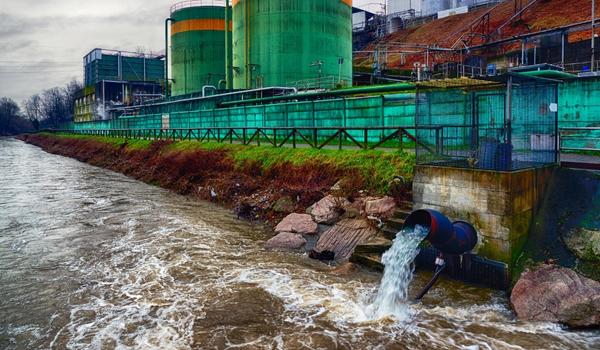
The government’s latest report on contamination is an eye-opener. According to the Environmental Protection Agency, it could be decades before your drinking water is safe.
If you’re one of the millions of Americans with “forever chemicals” in your water supply, the only real solution is a water filter. In this guide, you’ll find the expert guidance and product reviews you need to make a sound purchasing decision. We’re in your corner.
For definitive insights on persistent pollutants and other water contaminants, rely on EWG’s Tap Water Database. Simply input your zipcode for tailored, expert data.
How We Chose
It takes more than an ordinary activated carbon filter to tackle persistent chemicals. So, we did extensive research to identify leading filtration systems for removing these contaminants based on their quality, features, certifications and value.
We poured over reviews, analyzed customer feedback and scrutinized independent test results to find filters that excel in removing these persistent chemicals while offering user-friendly features. After using them personally, we’re confident that these are the best options for eliminating harmful substances from your tap water. If we wouldn’t use them in our homes, they wouldn’t be on this list.
Who Needs This Guide?
This guide is for anyone looking to understand more about the contamination of water supplies by persistent chemicals.
In it, you’ll learn:
- What “forever chemicals” are
- How they infiltrate water supplies
- Their potential impact on your health
- And what steps you can take to protect yourself
We’ll help you cut through the technical jargon and clarify any misleading advertising claims.
We also discuss:
- Different types of water filters for removing contaminants
- Key features to look for
- Price considerations, and more
If you have questions, we’ve got the answers.
What Are PFAS Chemicals?
“PFAS” is short for per- and polyfluoroalkyl substances. A revolutionary group of over 5000 man-made chemicals, they’re ubiquitous in a wide range of industrial, consumer and public safety products.
Developed in the 1930s, the strong carbon-fluorine bond in these chemicals makes them extremely durable, endowing products with water-, oil-, and stain-resistant properties.
These substances are found in:
- Fast food packaging
- Non-stick cookware
- Plastic bottles
- Carpets
- Upholstery
- Paint
- Ski wax
- Nail polish
- Deodorant
- Building materials
- Electrical wiring
- Batteries
- Fire-fighting foams
- Solar panels and more
How Does it Get into the Water Supply?
These chemicals are incredibly stable, resisting degradation for millennia. Unlike volatile organic compounds, they don’t easily evaporate. Instead, they travel through rainwater, seeping into soil, private wells, and public drinking water supplies.
Major sources of contamination include factories, landfills, and wastewater treatment facilities. Wastewater is especially problematic — most treatment plants don’t filter out these chemicals, allowing them to reenter water supplies used for irrigation. They contaminate biosolids, human waste used as fertilizer spreading pollutants to agricultural fields.
In a 2017 study, the Food and Drug Administration (FDA) confirmed that elevated levels of of these substances in fish, meats and even chocolate cake purchased at supermarkets on the Eastern seaboard. This is a global issue, making these chemicals nearly impossible to avoid.
Why Are These Chemicals Dangerous?
There are thousands of these chemicals, but to date, only a handful have been adequately studied. Initially, these substances were not expected to contribute to water pollution, catching researchers off guard.
Environmental science has advanced significantly since the risks of these contaminants were first identified in the late 1990s, but quality research takes time. Many questions still remain about the health effects and toxicity levels of specific chemicals across different age groups.
Those we’re aware of, however, are linked to a broad range of serious human health concerns. The worst offenders, PFOA and PFOS (perfluorooctanoic acid and perfluorooctane sulfonate) have largely been removed from the market but will continue to persist in soil and water for decades.
Supported by peer-reviewed studies, their effects may include:
- Low fertility
- Preeclampsia — pregnancy-related hypertension
- Stomach ulcers
- Developmental delays in children
- Low birth weight
- Accelerated puberty
- Behavioral disorders
- An increased risk of kidney, prostate and testicular cancers
- Hormone-related disorders
- Liver disease
- Impaired immune function
- High cholesterol and more
Do I Need a Water Filter That Removes These Chemicals?
The Environmental Protection Agency is taking strong action against contamination from these persistent chemicals. But according to the Environmental Working Group, a non-profit watchdog organization, the damage is already done. Testing shows that as many as a third of Americans drink tap water containing at least one of these substances.
The EPA recently issued a health advisory for PFAS chemicals, including PFOA and PFOS. But health advisories are not regulations. For now, the goal is simply to raise awareness about emerging contaminants while collecting data on the occurrence, testing, treatment and health effects of these contaminants. But until authorities develop a legally enforceable Maximum Contaminant Level (MCL), municipal water suppliers aren’t required to test for or remove these substances..
And while soil cleanup is underway in several states where contamination levels are high, it has yet to begin in most areas. Meanwhile, these dangerous chemicals that we know little about continue a slow creep into our water supplies.
As a consumer, it’s difficult to avoid exposure to these chemicals in soil, air, and food. However, you can significantly reduce your intake by ensuring your drinking water is clean. Even at very low concentrations, these substances can be toxic due to their cumulative health effects. Every step you take to minimize exposure counts — especially if you have kids.
The bottom line is that we have an unpredictable environmental crisis on our hands with no clear solution in sight, making a home filtration system the best protection for you and your family against toxic chemicals.
How to Test for PFAS in Water
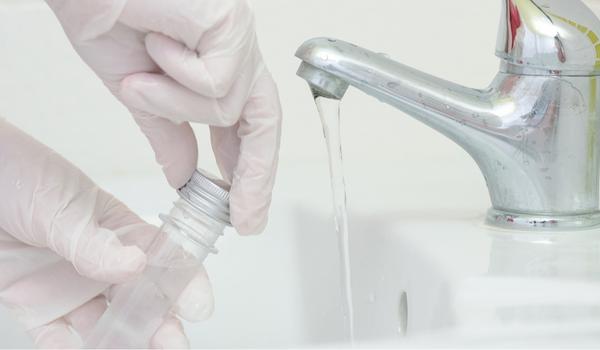
Testing for these chemicals requires precision, as they are measured in parts per trillion. For accurate results, we recommend sending a water sample to a certified drinking water laboratory for analysis.
If you don’t have one nearby, try Simple Lab’s Tap Score Water Test. It covers 14 of the most common forever chemicals, including PFOA and PFOS.
The testing process is simple and affordable. Kits include everything you need. Just collect a sample of your well or city water and mail it to their laboratory in the postage-paid box provided. You’ll get results in about a week, including a list of steps to take next. It’s actionable information.
How To Choose

A drinking water filter should fit your needs, budget and lifestyle. We used these criteria to choose the top performing filtration options.
PFOA and PFOS Removal Capability
PFOA and PFOS are the two most common PFAS contaminants in water, so filters with the highest reduction ratings will naturally be more impactful — don’t settle for less than 90%. The filters on our list eliminate 99% or more.
| Filtration Method | PFAS Removal | Benefits | Drawbacks |
|---|---|---|---|
| Activated Carbon | Moderate | Affordable, improves taste and odor, easy to install | May not catch all PFAS compounds, filters need replacement |
| Reverse Osmosis | High | Removes most PFAS and other contaminants, reliable performance | Higher upfront cost, produces wastewater, installation needed |
| Ion Exchange | High (for some PFAS) | Good for certain PFAS types, pairs well with other filters | Resin needs replacing regularly, system maintenance required |
Filtration Method
There are two general types of water filters — point-of-entry (POE) filters, whole-house systems that purify water throughout your home — and point-of-use (POU) filters, such as under-sink filters and water filter pitchers, that treat small volumes of water for drinking and cooking.
Whole-house filters are plumbed into your incoming water line, so every drop from every tap is clean. It’s a comprehensive solution if you own your own home.
But POU water filters can be equally effective without breaking the bank. Petite and portable, they’re a great option for nomads and renters. If you’re on a budget, six of our seven top filters for removing harmful chemicals are point-of-use systems, starting as low as $90.
Build Quality
Price and build quality aren’t always synonymous. But, in general, you get what you pay for. The last thing you want is a water filter that leaks or cracks under pressure.
We look for quality plastics, thick gaskets and waterproof design elements that prevent leaks. A good warranty is a bonus. Flimsy filters made of inferior materials didn’t make the cut.
Flow Rate
A water filter’s flow rate is the maximum number of gallons it can process per minute. Rates vary based on the type of filter and the size of the fittings.
Flow rate is critical among whole-house filtration systems. If it’s too low, you’ll notice a significant drop in water pressure when more than one tap is in use. The industry average of 6-7 gpm is suitable for average-sized homes. But for large houses with four or more bathrooms, the higher the flow rate the better. For this list, we insisted on 9 gpm or more.
Flow rate also affects the performance of water filter pitchers and under-sink filters, like reverse osmosis systems. But the differences between models are negligible. Among POU filters, performance and quality matter more.
Filter Capacity
Filter capacity is how many gallons systems treat before filters need to be changed. A top-shelf whole-house filter can handle a million gallons or more between maintenance intervals, while a water filter pitcher treats just 50-100 gallons over one to three months between filter replacements.
When it comes to removing contaminants, capability is more important than capacity. However, high-capacity filters are generally more convenient. A whole-house water filter produces gallons of clean water with the twist of a handle. You might refill a water filter pitcher two, three, or even four times daily to meet your drinking water needs.
The price of replacement filters also affects your long-term cost of ownership. Maintenance intervals for whole-house filters vary from 3-12 months or more — 1-3 months for POU filters. Frequent cartridge changes add up over time, so always do the math before buying a water filter.
Installation & Maintenance
Whole-house water filters are straightforward to install, but they require permanent changes to your plumbing system. We recommend hiring a professional if you’re not comfortable cutting pipes. It’ll cost you, but you’re better safe than sorry.
Any homeowner can assemble a water filter pitcher or countertop filter. Reverse osmosis systems are slightly more challenging. But they take more time than skill to install, and you’ll save hundreds in plumber’s fees.
Maintenance chores are relatively simple for both POE and POU water filter systems. Manufacturers go out of their way to make them foolproof.
No matter which type of filter you choose, timely maintenance is essential. A clogged filter loses its effectiveness in removing contaminants. In fact, studies show that a poorly maintained activated carbon filter can actually increase the concentration of harmful substances in tap water. Therefore, it’s crucial to select a model that you can afford to maintain both in terms of time and money.
Certifications
The EPA regulates water safety under the US Safe Drinking Water Act. And some states, like California, set even stricter standards. But neither tests nor certifies water treatment systems. For that, we rely on the National Sanitation Foundation (NSF).
NSF-certified products are independently tested and guaranteed to:
- Be structurally sound
- Contain no hazardous materials
- Meet performance claims
It’s the best protection consumers have against manufacturers that overpromise and underdeliver.
Several NSF standards apply to drinking water treatment systems, including:
NSF 42
Standard 42 applies to filters that remove taste and odor impurities. Most activated carbon filters fall into this category.
NSF 53
Standard 53 addresses contaminant reduction claims for substances with known health effects, like lead.
NSF 58
Standard 58 applies only to reverse osmosis filters and evaluates contaminant reduction claims for EPA-regulated substances.
PFAS, however, are not yet regulated, so how do these standards apply?
From 2016 to mid-2021, filters designed to remove these chemicals were evaluated under a temporary standard, P473. Since then, new test methods have been approved and incorporated into the NSF 53 and 58 testing criteria. Some promotional materials may still reference P473 certification, which is fine. However, NSF 53 and 58 standards are now equally effective for assessing the removal of these contaminants.
Other Contaminants Present
Most filters designed to remove persistent chemicals also tackle other common drinking water contaminants, such as VOCs and heavy metals. However, some filters are more effective than others. If your water test results revealed multiple issues, it’s important to choose your filter carefully.
Among whole-house filters, those with regular activated carbon media remove 70%-90% of contaminants. Models equipped with catalytic carbon and KDF eliminate 99% or more of forever chemicals plus other contaminants, including heavy metals like lead. Neither, however, removes fluoride or total dissolved solids. There’s always give and take.
Among point-of-use filters, granular activated carbon and reverse osmosis systems both remove “forever chemicals.” But reverse osmosis filters are far more efficient. And while they also remove fluoride and other heavy metals, they virtually eliminate total dissolved solids — the natural minerals that give drinking water a refreshing quality.
Removing forever chemicals is important, but it shouldn’t come at the expense of taming more dangerous contaminants. The health risks increase with time, but they’re limited in the short term. Lead, however, can cause irreversible damage to the human body within months. Choosing a water filter is a balancing act.
Manufacturer Hype & User Experience
Manufacturers aren’t shy about hyping their filters. But there’s no substitute for the user experience, so we’ve examined customer feedback across dozens of websites to understand what’s most important to buyers.
We look for honest appraisals of quality and function from people who’ve owned a filter for at least six months. Most are remarkably fair. In general, positive reviews reflect satisfaction with a product’s performance as advertised. Nothing turns buyers off more than false or misleading claims.
We urge you to be cautious, however, when considering negative comments. Some folks are quick to leave dismal reviews because of issues that don’t reflect the quality of the product or the manufacturer, such as one-of snafus with the shipping company.
Others don’t do their due diligence when it comes to research. We weed out bad reviews from people who chose the wrong product in haste unless it was misrepresented by the company. Similarly, we look over owner manuals and installation instructions to see if “hard to install” criticisms are fair.
We set the bar high, however, for quality and customer service — so should you. Problems aren’t always the manufacturer’s fault, but how they deal with them reflects the service you can expect after the sale.
Best Value for The Money
Water filters with similar abilities may have vastly different price tags. It’s hard to know if you’re paying for valuable features or unnecessary bells and whistles.
Our selection process assigns more weight to performance, ease of installation and maintenance costs than convenience features. But no one filter is right for everyone. Lifestyles differ, so you need to consider what matters the most to you.
Frequently Asked Questions
Reverse osmosis systems are the most effective for removing these persistent chemicals, followed by distillers and catalytic carbon filters.
All of the filters in our list have been tested and certified to remove PFOA and PFOS.
The average activated carbon filter removes less than 75% of these contaminants. That’s not good enough for us and it shouldn’t be good enough for you. Efficiency counts.
Most refrigerator filters are basic carbon models that don’t significantly reduce these contaminants. However, there are exceptions, such as the Clearly Filtered Universal Inline filtration system and GE’s RPWFE.
No. Because PFAS have a higher boiling point than water, boiling increases the concentration of chemicals in the remaining volume.
Brita filter pitchers don’t. But Brita will soon be introducing a first-of-its-kind whole-house water filter that does — the PFAS Titanium Series.
Yes, they have been found in plastic bottles, including those used for water. A byproduct of the molding process, they can’t be entirely eliminated. Filtering your water is generally a safer option.
Michigan has the highest level of contamination, followed by California, Colorado, Texas and Pennsylvania. Nationwide, however, testing is limited, so we encourage you to call state and local authorities.
According to the Environmental Working Group, 2,858 locations across 50 states are known to be contaminated. Cities with these chemicals in the public drinking water supply include Kalamazoo, Michigan, Abilene, Texas, Richmond, Virginia, Oklahoma City, Oklahoma, Durham, North Carolina, Anaheim, California and dozens more.
These substances takes 1000 years or more to degrade under normal circumstances. But groundbreaking research from Northwestern University shows that two common household chemicals — lye and dimethyl sulfoxide — may someday be able to treat forever chemicals in both the soil and water.
 129 people found this helpful. Was this guide helpful to you?
129 people found this helpful. Was this guide helpful to you? 
